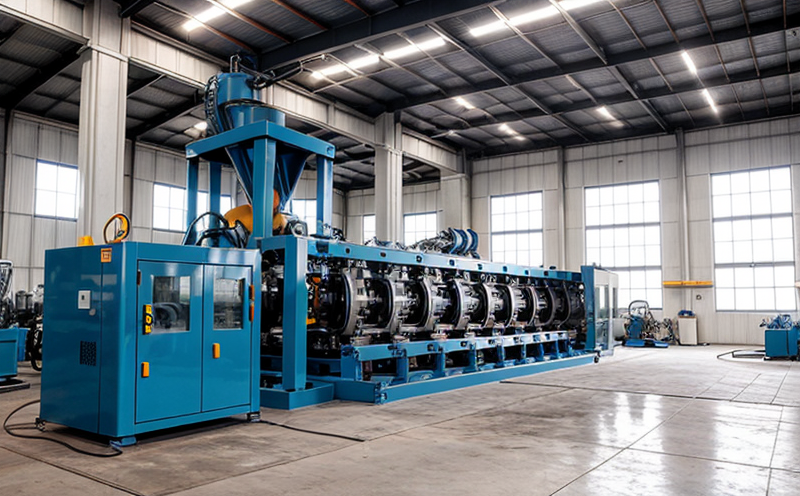ASTM B117 Salt Spray Performance Testing of Machinery Components
The ASTM B117 salt spray test is a widely recognized standard used to evaluate the corrosion resistance of materials and coatings, particularly in industrial manufacturing. This testing method simulates the corrosive environment found in marine atmospheres and other environments where salt-laden air can significantly influence material performance.
For machinery components, this test helps manufacturers ensure that their products will withstand harsh conditions without compromising on functionality or longevity. The ASTM B117 standard is particularly useful for industries such as automotive, aerospace, and marine engineering, where the durability of materials under salt spray exposure is crucial.
The process involves subjecting samples to a continuous mist of neutral saltwater solution (5% sodium chloride) at an elevated temperature. The duration can vary depending on the specific requirements set by the client or regulatory bodies. Typically, this test runs for 48 hours, but longer durations may be necessary for more thorough evaluations.
Specimens are carefully prepared according to ASTM B117 guidelines before being placed in a salt spray chamber. Proper specimen preparation ensures accurate and reliable results. This includes cleaning the surface of contaminants, ensuring uniformity across all test samples, and applying any relevant coatings or treatments if required by the client.
During testing, it is crucial to monitor environmental conditions such as temperature, humidity, and mist concentration rigorously. These parameters can significantly impact the outcome of the test. After exposure, the specimens are inspected for signs of corrosion, including pitting, rusting, or changes in appearance that could indicate material degradation.
The results from ASTM B117 salt spray testing provide valuable insights into how well a component will perform under real-world conditions. These tests help manufacturers identify potential weaknesses early on, allowing them to make necessary adjustments before product launch. By adhering to standards like ASTM B117, companies can ensure their machinery components meet stringent quality and reliability expectations.
Understanding the nuances of this testing method is essential for achieving consistent results that are both reproducible and relevant to actual usage scenarios. Proper preparation, adherence to procedural guidelines, and thorough analysis post-exposure all contribute to making ASTM B117 salt spray tests a reliable tool in quality assurance programs.
Scope and Methodology
The scope of the ASTM B117 salt spray test extends beyond just laboratory conditions; it encompasses various aspects relevant to industrial manufacturing. This includes not only the physical properties of materials but also their behavior in simulated environments that mimic real-world applications.
One key aspect is the selection and preparation of specimens for testing. Specimens should be representative of the final product design, including any coatings or treatments applied during production processes. Proper cleaning and drying are vital steps to prevent contamination from external factors before placing them into the salt spray chamber.
The methodology involves several stages: setup, conditioning, exposure, inspection, and reporting. Setup includes configuring the test chamber according to specified parameters such as temperature and humidity levels. Conditioning allows specimens time to acclimatize within these controlled conditions prior to actual exposure.
Exposure begins by introducing a continuous mist of saltwater vapor into the chamber. Inspection follows at predetermined intervals throughout the duration of the test, typically every 24 hours until corrosion appears or after reaching a set period if no visible signs are present. Reporting involves documenting all observations made during inspections along with any data collected regarding environmental conditions.
It’s important to note that while ASTM B117 provides clear instructions on how to perform these tests, each laboratory must adapt procedures slightly based on equipment capabilities and specific requirements from clients or regulatory bodies. Compliance with international standards ensures consistency across different facilities performing similar types of tests.
Benefits
- Enhanced Durability: Identifies weaknesses early in the development process, allowing for improvements that extend product life span.
- Increased Reliability: Ensures that machinery components can withstand harsh environmental conditions without compromising on performance or integrity.
- Promotes Innovation: Encourages continuous improvement by providing actionable data on material and coating effectiveness.
- Avoids Failures: Reduces the risk of failures in critical areas leading to downtime, maintenance costs, and potential safety hazards.
- Risk Mitigation: Helps predict future issues before they occur, minimizing long-term operational risks associated with corrosion damage.
- Compliance Assurance: Ensures that products meet industry-specific standards and regulations related to material resistance against salt spray exposure.





